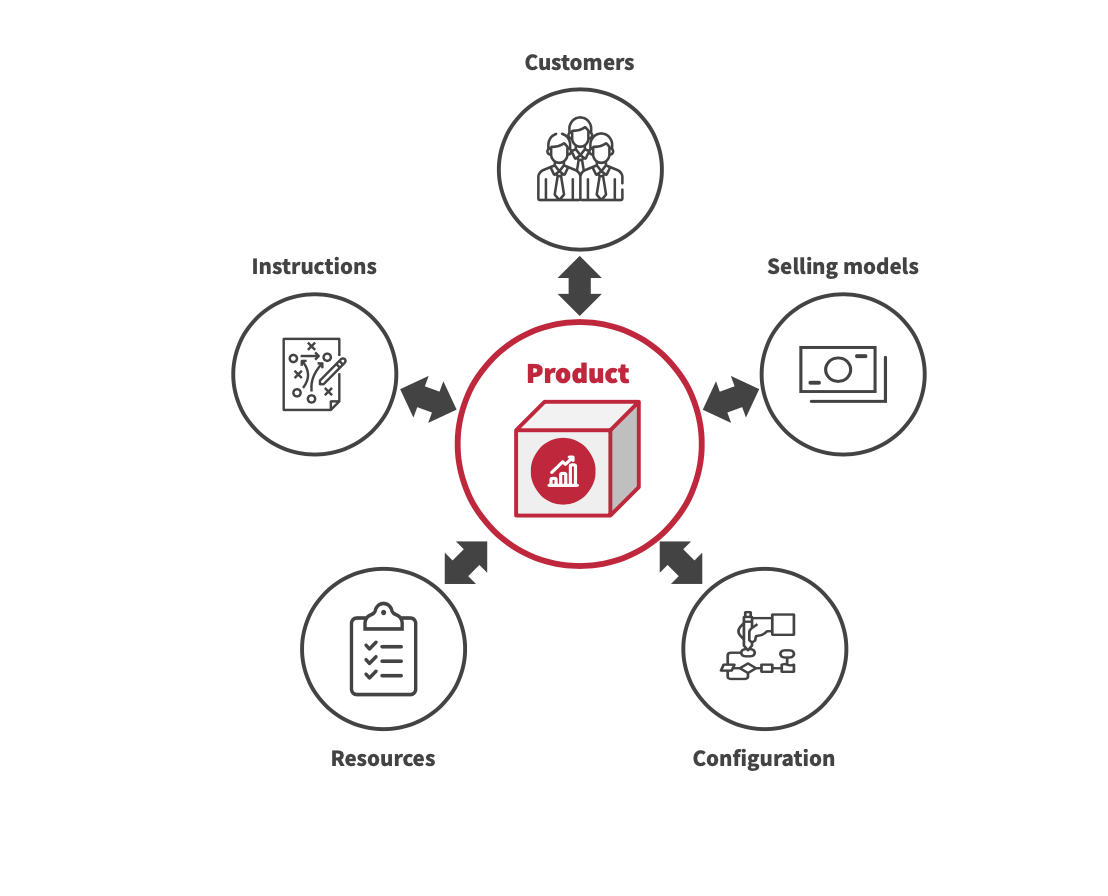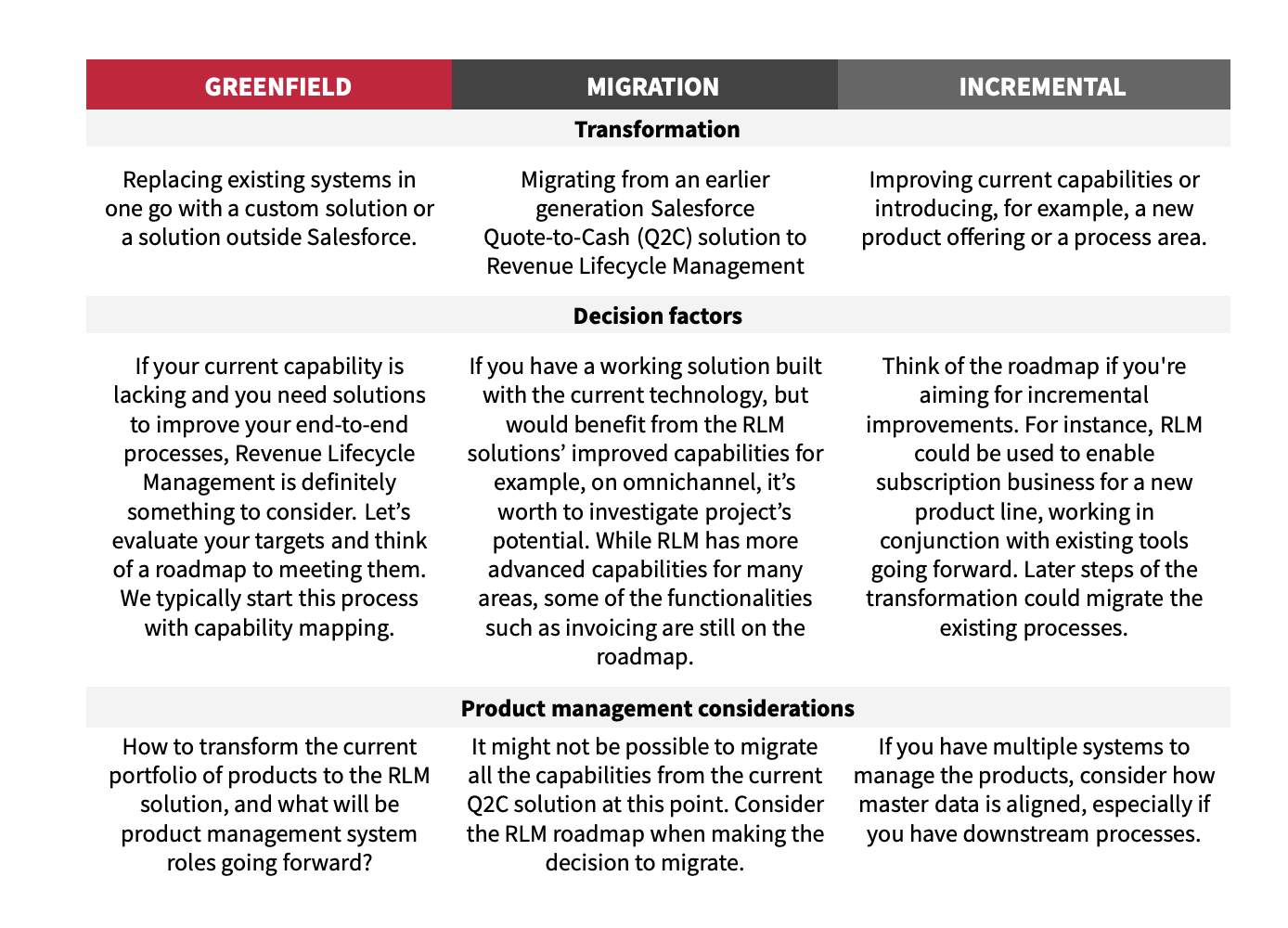Blog
24/07/2024
Revenue Lifecycle Management: a product management insight
Explore how Salesforce's Revenue Lifecycle Management can benefit product management from product launch to delivery and up-sales opportunities, and what to consider in the transformation process.
Earlier in spring, Salesforce launched Revenue Lifecycle Management (RLM), a full overhaul of features and tighter integration of its various current products serving their customers’ revenue operations and management needs (including CPQ, CLM, Revenue Cloud, and Subscription Management). In my previous article, I overviewed RLM from the process perspective. As the topic is profound, encompassing many of the company’s sales and delivery processes, I’ll dig into each domain separately.
Now I’ll be diving into the RLM from a product management point of view. I’ll discuss how RLM can take your product management to the next level from product launch to up-sales potential and what needs to be considered in the transformation process.
Product management from the business perspective
Previously I was working as a product manager in a manufacturing company. I was responsible for the offering portfolio from product development to market launches, and supporting sales execution while also covering sales support materials. As everybody in product management or related roles knows, this is a large area to cover, and you want to take all the available help. One aspect that helps is smoothly working and seamlessly integrated systems – and that’s where Salesforce solutions such as Revenue Cloud, Commerce, Data Cloud, and Mulesoft can help you.
Let’s explore some of the responsibilities, aspirations, and challenges faced by product management in the product lifecycle’s different stages. I’ll mainly focus on the areas which are related to the revenue lifecycle management processes:

While the different lifecycle management stages can seem isolated, they are interconnected: launch activities already include tasks related to selling and delivering the products. However, for the sake of simplicity, I’ll dig deeper into each topic separately. In the next chapter, I’ll concentrate on the system perspective, but let’s first set the stage with business considerations. While the issues are general to all industries, I’ll approach the topics mainly from a B2B perspective.
Product launch
Planning a product launch includes multiple activities, such as marketing, sales models, and product delivery – you must be ready to market, sell, and deliver the product from the processes and systems point of view. You must establish the product offering to the sales and delivery systems. Companies with complex products might use multiple systems like PLM, CRM, CPQ, Invoicing, and ERP. Salesforce RLM solution provides tools for managing product catalogues, pricing, and connecting the downstream processes.
Sales
To get the products to customers’ hands you must engage in sales activities first, be it internal sales or self-service/commerce systems. From this point on, the approaches differ significantly by industry: when selling complex products (from a purchasing angle, such as manufacturing equipment), guiding the internal sales in creating the offers may be the most important matter in the product manager’s mind. In turn, when selling simple products (like mobile phones or software subscriptions not requiring much configuration), the user experience is more important.
Naturally, both of these use cases can be relevant for a company. Imagine, for example, selling complex manufacturing systems and then upselling subscriptions and services on top. Regardless of the industry, product managers think about how to build the offering to support omnichannel sales and promote sales of the most desired and profitable solutions. Guided selling and product qualification capabilities can help with these efforts.
Delivery
After selling the products, they still need to be delivered, and that’s where the profitability of a product will be defined. The delivery includes many different areas. First, you transfer the sale or purchase, both for tangible and intangible products, to the delivery phase. In the coordination phase, you want to transfer the data from the sales (or self-service) organisation to the delivery organisation.
In the delivery phase, you want to ensure the customer receives the product. Especially when selling engineering to order products, transfer from sales to delivery is a critical part of the process: how can you ensure that the product and sales-specific data is passed to the delivery organisation accurately and efficiently?
End-to-End Process
Let’s take a look at the end-to-end product-to-cash process: one of the goals for product data management is to enable the organisation to perform each of the process steps as efficiently as possible, removing manual steps, promoting data transparency and improving customer experiences.

From the product management point of view, the process does not end at the first box. Product data must flow through every step of the process. Next, I’ll discuss the technical considerations: which capabilities are required to streamline the above processes, how RLM solutions can address the areas, and what to consider with the Salesforce RLM solution.
Product management from the technology perspective
What should you consider when selecting and implementing tools for RLM processes? The following image illustrates a few areas to consider when enabling your product to be ready to be sold and delivered.

Customers
First, you need to think about your product’s ideal customer. From the systems’ point of view, this means a few things. First, how can you enable your products to be sold to the target customers, and how can you make sure that sales and customers will find the product?
When thinking about this from the data point of view, you need to address topics like product catalogues, price books, product entitlements, and qualification rules, while in the background you need to have information about your segmentation practices.
Consider an example: your product is mainly aimed at small- to mid-sized companies and is available in the EMEA area only. In this case, you should ensure the product is available for sale in defined areas and highlighted for target customers only. RLM introduces multiple improvements on this front, from providing tools for product discovery and contracted price domains to helping quote the correct and available products with customer-specific pricing. On the other hand, when combining customer segmentation data (to start with) for example with the help of data cloud, we can drive personalised recommendations across channels.
Selling models
Selling models are at the core of defining how products are sold. For example, is a product sold as a subscription, a fixed one-time product, or even both? Selecting the selling model has major implications on downstream processes. Consider, for example, invoicing, where one-time invoicing is relatively simple and can be easily managed with most of the legacy systems, whereas recurring subscription invoicing requires more advanced capabilities.
On the other hand, sales pricing models are likely to differ significantly as well. From the systems angle, these questions are exactly what the RLM solution addresses: enabling subscription business is one of the key themes across industries, from software and services to other areas. Building the product foundations for the subscription business is one of the key topics in the transformation, and requires a lot of business capabilities to master.
Flexible selling model capability is one of the key improvements in the RLM solution. With it, you can define multiple selling models for the same product. For example, if a software product is sold as a cloud and on-premise solution, you can easily use the same product and server structures in the background. From the solutions point of view, selling models come into play also when exposing the products across channels, such as self-service in the Salesforce commerce cloud.
Product configuration
Product configuration is a multifaceted topic. Some products require complex configuration, whereas others are available from the shelf, and a company can sell both or anything in between. This can be challenging from the systems’ perspective, as one needs flexible tools providing advanced configuration capabilities while maintaining a good user experience for simpler products.
This is a common topic in our CPQ and selling system implementations. The new RLM solution is taking a big step forward on this front with its composable product configuration and pricing capabilities. We can build tailored experiences for each of the use cases.
When considering the most complex configurations for manufacturing, RLM can also integrate external configurators with RLM APIs, meaning that one can for example concentrate on the product-to-cash end-to-end process improvements with RLM while still configuring the products in external systems – this provides also possibilities to split the project in phase in case replacing those systems is a long term goal. When implementing the project, the configuration approach is one of the key matters to address to ensure the modelling principles are in place.
While RLM capabilities currently are already adequate for many configuration use cases, in the coming releases we can expect many more capabilities for complex configuration rules and guided selling front. Before that, you can check for example Logik.io, which offers a great extension to Salesforce configuration capabilities.
Product information management
For sales and delivery, product resources and instructions have a major role. By definition, resources means, for example, documents from PIM (product information management) and PLM (product lifecycle management) systems. On the other hand, instructions can be either built-in to the data structures (such as invoicing and tax rules), or checklists to execute certain operations.
With the RLM solution, you can automate, or at least guide users, through the downstream processes with the new Dynamic Revenue Orchestration capability. One of the main questions from the systems’ point of view is to define the roles of each system in the process. For example, where the role of the sales systems ends, and delivery systems start (this could be when an order is activated). With order management and orchestration, you can automate or at least guide users to perform subscription provisioning, workload management, and ERP order creation phases, to name a few.
Revenue Lifecycle Management product suite addresses all these areas, and starting the journey can be relatively easy. Let’s explore a couple of different scenarios and question whether a transformation is potential.
Accelerating your business with RLM
Finally, we’ll get to the question many of our customers have asked: “Can I accelerate my business with RLM and how should I approach the transformation?” While the RLM vision is comprehensive and addresses all topics covered, the question is not simple.
You most likely already have existing systems for managing and selling your products either on top of Salesforce, integrated into it, or a completely stand-alone system (or maybe you don’t have Salesforce in place to start with). Naturally, you cannot make these decisions only from a product management point of view, so in the following, I’ll consider the big picture but include considerations from the product management perspective.
In my previous article, I discussed two different scenarios: greenfield implementations and gradual improvement projects. As a third option, let’s consider migrations. If you already have a solution built with, for example, Salesforce Quote to Cash solution, the project sits between these two. Let’s summarise the situation from these perspectives:

The RLM projects might be complex as product-to-cash projects touch multiple process domains and span through various systems. We at Fluido can help you in the transformation and evaluation process to address the technical solution and roadmap.
If you’re starting the product-to-cash journey from scratch, the answer is clear: you should definitely explore how your business targets can be met with the RLM solution.
If you have a sophisticated or custom solution built already with the current technologies and would like to develop some of the areas discussed here, we can incorporate RLM modules into your existing solution and gradually transform the end-to-end processes. For example, if the main goal for business is to enable subscription management and self-service buying experiences, with composable architecture we can start from this angle, and concentrate on the configuration experiences later.
While RLM is a novel product, some of its capabilities are on the roadmap, and hence migration from the existing Quote-to-Cash solution might not be topical in case the existing solution meets your current business needs. We can evaluate together whether the benefits of the RLM solution can already motivate the migration efforts – or would it be better to wait before considering a transition.
Let’s think together about how the transformation process could start or what improvements could be introduced to your current processes and solutions. If you have any questions you can send me a message or contact our sales team. Or if you have any specific topics you’d like to hear more about, I’m happy to have some feedback.

Santtu Kumpulainen
RLM Practice Lead & Architect at Fluido
santtu.kumpulainen@fluidogroup.com
Read next
24/07/2024
